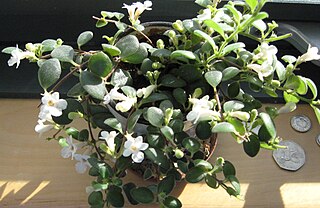
The Caribbean pine is a hard pine species native to Central America and the northern West Indies. It belongs to subsection Australes in subgenus Pinus. It inhabits tropical and subtropical coniferous forests such as Bahamian pineyards, in both lowland savannas and montane forests.

The yellow-crowned amazon or yellow-crowned parrot is a species of parrot native to tropical South America, Panama and Trinidad and Tobago in the Caribbean. The taxonomy is highly complex and the yellow-headed and yellow-naped amazon are sometimes considered subspecies of the yellow-crowned amazon. Except in the taxonomic section, the following deals only with the nominate group .They are found in the Amazon basin.

The ring-tailed pigeon is a species of bird in the family Columbidae. It is endemic to Jamaica.

Codonanthe is a genus of mainly epiphytic plants in the family Gesneriaceae, endemic to the Atlantic Forest of Brazil. The botanical name comes from the Ancient Greek for 'bellflower'. They have white or pale pink flowers and somewhat fleshy leaves. In 2013, the genus was reduced in size when more than half of the species were transferred to Codonanthopsis. They can be grown as houseplants, particularly in hanging baskets. Artificial crosses with Nematanthus hybrids have produced the hybrid genus × Codonatanthus.
Coralliophila caribaea is a species of sea snail, a marine gastropod mollusk in the family Muricidae, the murex snails or rock snails.

Simulamerelina caribaea is a species of minute sea snail, a marine gastropod mollusk or micromollusk in the family Rissoidae.

The Cuban pine forests are a tropical coniferous forest ecoregion on the Caribbean islands of Cuba and Isla de la Juventud. They cover an area of 6,400 km2 (2,500 sq mi), occurring in separate sections in eastern Cuba and western Cuba and Isla de la Juventud.

Hymenocallis caribaea is a flowering plant in the family Amaryllidaceae. The species was first described by Linnaeus and later assigned its current name by Herbert.
Codonanthopsis elegans is a plant species in the family Gesneriaceae. It is endemic to Belize.

The Gesnerioideae are a subfamily of plants in the family Gesneriaceae: based on the type genus Gesneria. Although genera typically originate in the New World, some species have become widely distributed as ornamental plants.

An ant garden is a mutualistic interaction between certain species of arboreal ants and various epiphytic plants. It is a structure made in the tree canopy by the ants that is filled with debris and other organic matter in which epiphytes grow. The ants benefit from this arrangement by having a stable framework on which to build their nest while the plants benefit by obtaining nutrients from the soil and from the moisture retained there.
Caryocorbula is a genus of saltwater clams belonging to the Corbulidae family, classified as marine bivalve molluscs.: This genus is often referred to as corbula and serracorbula instead of caryocorbula.

Codonanthopsis is a genus of flowering plants in the family Gesneriaceae. Its native range is from southern Mexico through tropical America to Bolivia and most of Brazil. Codonanthopsis species are generally trailing epiphytes with pale flowers. Most have a mutualistic relationship with tree-living ants: the plants provide the ants with food, including nectar, and give their nests structure and support, while the ants disperse the plants' seeds. The genus was considerably expanded in 2013 when species were transferred from Codonanthe. Some Codonanthopsis species are cultivated as houseplants, when they may be grown in hanging baskets.

Codonanthopsis crassifolia is a species of plant in the family Gesneriaceae.
Codonanthopsis calcarata is a species of flowering plant in the family Gesneriaceae. This species is native to Bolivia, Brazil North, Brazil West-Central, Colombia, French Guiana, Guyana, Suriname, and Venezuela. Codonanthopsis calcarata is an epiphyte, and mainly grows in wet tropical biomes. Codonanthopsis calcarata was first published in 2013.
Codonanthopsis corniculata is a species of flowering plant in the family Gesneriaceae. This species is native to Peru and mainly grows in wet tropical biomes. The species was first described as Codonanthe corniculata by Hans Wiehler in 1977. In 2013 it was placed in genus Codonanthopsis as Codonanthopsis corniculata.
Codonanthopsis dissimulata is a species of flowering plant in the family Gesneriaceae. This species is native to northern Brazil, Colombia, Ecuador, French Guiana, Guyana, Peru, and Venezuela. Is an epiphyte and mainly grows in wet tropical biomes. The description was first published in 1978.
Codonanthopsis erubescens is a species of flowering plant in the family Gesneriaceae. This species is native to Ecuador and mainly grows in wet tropical biomes. Codonanthopsis erubescens was first published in 2013.
Codonanthopsis macradenia is a species of flowering plant in the family Gesneriaceae. This species is native to Belize, Colombia, Costa Rica, Guatemala, Honduras, Mexico, and Panamá, and mainly grows in subtropical biomes. Codonanthopsis macradenia was first published in 2013.

Codonanthopsis uleana is a species of flowering plant in the family Gesneriaceae. This species is native to Mexico and America. Is an epiphyte and mainly grows in wet tropical biomes.











